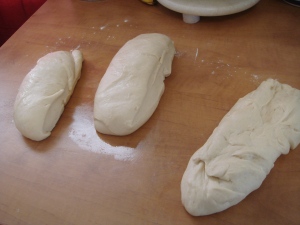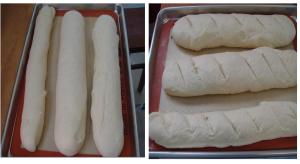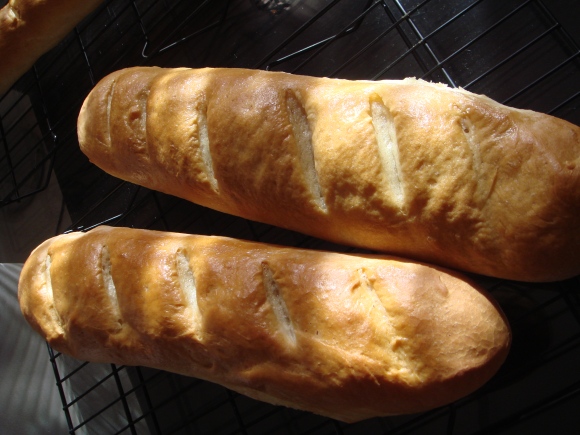These days my bedside novel is Peter Reinhart’s The Bread Bakers’ Apprentice. I am in love with this book. Last night, even though I was sleepy I couldn’t put the book down- like it was some really interesting crime mystery novel and I was at the part where the murder was just seconds from getting solved. No one would have thought, especially those who have seen me growing up, that I was so passionate about baking. I too never knew till only recently, and even though I am not a great baker – I’ll call myself that only when I am able to concoct my own recipes- I know that I’m passionate about this. And, believe me, if you find something you are passionate about- you can and will eventually become great at it. Until that day I’ll keep trying!
Inspired by Reinhart’s words, I decided to try my hand at his version of French Bread.
Bread – a combination of flour, water, salt and yeast- all combined to form this beautifully fermented dough with layers of flavor hidden in it. One bite into the bread- and I’m talking about the freshly baked kinds- not the store bought, kept on shelves, filled with preservatives kinds- and you are like- whoa…oh my god, this is it- Yes! almost like having an orgasm for the mouth!
Previously, I have tried making French Bread with decent results. Reinhart’s version is slightly different and does require more time in the preparation. He starts off with a pre-fermented dough, pâte fermentée (dough that has been kept overnight to ferment in the refrigerator). The resulting bread has a sweetness associated with it due to the sugars released from the starches during fermentation. The crust is nice and rustic on the outside and the bread full-flavored!
Use this bread for making garlic bread or serve it with a roasted garlic infused ricotta cheese topping or use it to make your own version of crostinis!
FRENCH BREAD
makes 3 loaves
INGREDIENTS
3 cups pâte fermentée (recipe here)
1 1/4 cups unbleached all-purpose flour
1 1/4 cups unbleached bread flour
3/4 tsp salt
1/2 tsp instant yeast
3/4 cup to 3/4 cup plus 2 tbsp water, lukewarm (90°F to 100°F)
Semolina flour or cornmeal for dusting
DIRECTIONS

1. Remove the pâte fermentée from the refrigerator 1 hour before making the dough. Cut it into about 10 small pieces with a pastry scraper or serrated knife. Cover with a towel or plastic wrap and let sit for 1 hour to take off the chill.

2. Stir together the flours, salt, yeast, and pâte fermentée pieces in a 4-quart bowl (or in the bowl of an electric mixer). Add the water, stirring until everything comes together and makes a coarse ball (or mix on low speed for 1 minute with the paddle attachment). Adjust the flour or water, according to need, so that the dough is neither too sticky nor too stiff. (It is better to err on the sticky side, as you can adjust easier by adding more flour during kneading. It is harder to add water once the dough firms up.)
 3. Sprinkle flour on the counter, transfer the dough to the counter, and begin to knead ( or mix on medium speed with the dough hook). Knead for about 10 minutes (6 minutes by machine), or until the dough is soft and pliable, tacky but not sticky, and all the pre-ferment is evenly distributed. the dough should pass the windowpane test (see picture), and register 77° to 81° F. Lightly oil a large bowl and transfer the dough to the bowl, rolling it around to coat it with the oil. Cover the bowl with plastic wrap.
3. Sprinkle flour on the counter, transfer the dough to the counter, and begin to knead ( or mix on medium speed with the dough hook). Knead for about 10 minutes (6 minutes by machine), or until the dough is soft and pliable, tacky but not sticky, and all the pre-ferment is evenly distributed. the dough should pass the windowpane test (see picture), and register 77° to 81° F. Lightly oil a large bowl and transfer the dough to the bowl, rolling it around to coat it with the oil. Cover the bowl with plastic wrap.
4. Ferment at room temperature for 2 hours, or until the dough doubles in size. If the dough doubles in size before 2 hours have elapsed, knead it lightly to degas and let it rise again, covered, until it doubles fromt he original size.
5. Gently remove the dough from the bowl and transfer it to a lightly floured counter. For baguettes, cut the dough into 3 equal pieces with a pastry scraper or serrated knife.  Again, take care to degas the dough as little as possible. Form the pieces into baguettes. Leave them for proofing on a parchment lined baking sheet dusted with semolina or cornmeal.
Again, take care to degas the dough as little as possible. Form the pieces into baguettes. Leave them for proofing on a parchment lined baking sheet dusted with semolina or cornmeal.
6. Proof at room temperature for 45 to 75 minutes, or until the loaves have grown to about 1 1/2 times their original size. They should be slightly springy when poked with a finger.
7. Prepare the oven for hearth baking by making sure to have an empty steam pan in place. Preheat the oven to 500°F. Score the baguettes ( using a blade or a serrated knives make cuts as shown in the picture below).
8. Pour 1 cup hot water into the steam pan and close the oven door. Be very careful while doing this and make sure you keep  your head at a distance from the oven, because hot steam will splurt as soon as you pour the hot water. After 30 seconds, spray the oven walls with water and close the door. Repeat twice more at 30 second intervals. After the final spray, lower the oven setting to 450°F and bake for 10 minutes. Rotate the loaves 180 degrees, if necessary, for
your head at a distance from the oven, because hot steam will splurt as soon as you pour the hot water. After 30 seconds, spray the oven walls with water and close the door. Repeat twice more at 30 second intervals. After the final spray, lower the oven setting to 450°F and bake for 10 minutes. Rotate the loaves 180 degrees, if necessary, for  even baking and continue baking until the loaves are a rich golden brown and register at least 205°F at their center. This can take anywhere from 10 to 20 additional minutes, depending on your oven and how thin your baguettes are. if they seem to be getting too dark but are not hot enough internally, lower the oven setting to 350°F (or turn it off) and continue baking for an additional 5 to 10 minutes.
even baking and continue baking until the loaves are a rich golden brown and register at least 205°F at their center. This can take anywhere from 10 to 20 additional minutes, depending on your oven and how thin your baguettes are. if they seem to be getting too dark but are not hot enough internally, lower the oven setting to 350°F (or turn it off) and continue baking for an additional 5 to 10 minutes.
9. Remove the loaves from the oven and cool on a rack for at least 40 minutes before slicing or serving.





Pingback: Homemade Dinner rolls/ Pav Buns - The Novice Housewife